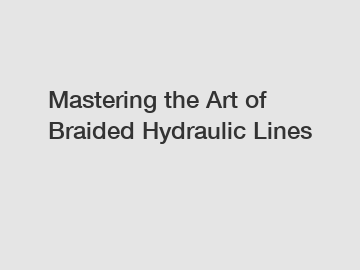Braided hydraulic lines are essential components in hydraulic systems, responsible for carrying pressurized fluids between various components. Mastering the art of creating these lines is crucial to ensuring the efficiency and safety of hydraulic systems. Whether you are a novice or an experienced technician, understanding the best practices for crafting braided hydraulic lines is key. In this article, we will explore the steps and techniques involved in mastering the art of braided hydraulic lines.
Choosing the Right Materials.
The first step in creating high-quality braided hydraulic lines is selecting the right materials. It is essential to choose a high-quality hose that can withstand the pressures and temperatures of the hydraulic system. Additionally, selecting the appropriate fittings and adapters is crucial to ensure a secure connection and prevent leaks.

Measuring and Cutting.
Accurate measurements are essential when creating braided hydraulic lines to ensure a proper fit and optimal performance. Using a hose cutting machine or a sharp utility knife, cut the hose to the required length. Be sure to make clean, square cuts to prevent leaks and ensure a secure connection.
Assembling the Fittings.
After cutting the hose to size, it is time to assemble the fittings. Start by inserting the hose into the fitting, ensuring that it is fully seated. Use a crimping machine to crimp the fitting onto the hose, creating a tight seal. Be sure to follow the manufacturer's guidelines for the specific hose and fitting combination to ensure proper assembly.
Crimping the Hose.
Crimping the hose is a critical step in creating braided hydraulic lines. The crimping process compresses the fitting onto the hose, creating a strong, leak-proof connection. Use a crimping machine that is appropriate for the size and type of hose and fitting being used. Be sure to follow the manufacturer's instructions for proper crimping techniques to ensure a secure connection.
Testing and Inspection.
Once the hose has been assembled and crimped, it is essential to test and inspect the braided hydraulic line. Pressure test the line to ensure that it can withstand the pressures of the hydraulic system. Additionally, visually inspect the line for any signs of damage, such as leaks or bulges. Be sure to follow safety protocols when pressure testing hydraulic lines to prevent accidents or injuries.
Conclusion.
Mastering the art of braided hydraulic lines is a valuable skill for technicians working with hydraulic systems. By choosing the right materials, measuring and cutting accurately, assembling fittings correctly, crimping the hose securely, and testing and inspecting the line, you can create high-quality braided hydraulic lines that are both efficient and reliable. Remember to follow best practices and safety guidelines throughout the process to ensure optimal performance.
Contact Us.
If you need assistance with mastering the art of braided hydraulic lines or have any questions about hydraulic systems, don't hesitate to contact us. Our team of experts is here to help you with all your hydraulic system needs.
Are you interested in learning more about china hose accessories manufacturer, 100r17 hydraulic hose specification, car aircon hose? Contact us today to secure an expert consultation!


Comments
Please Join Us to post.
0